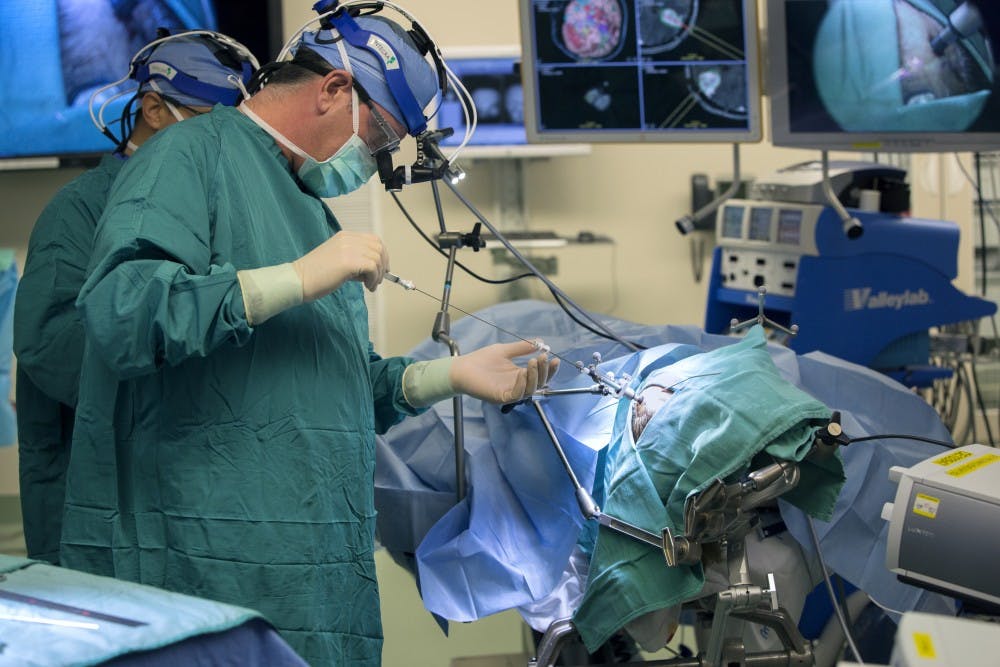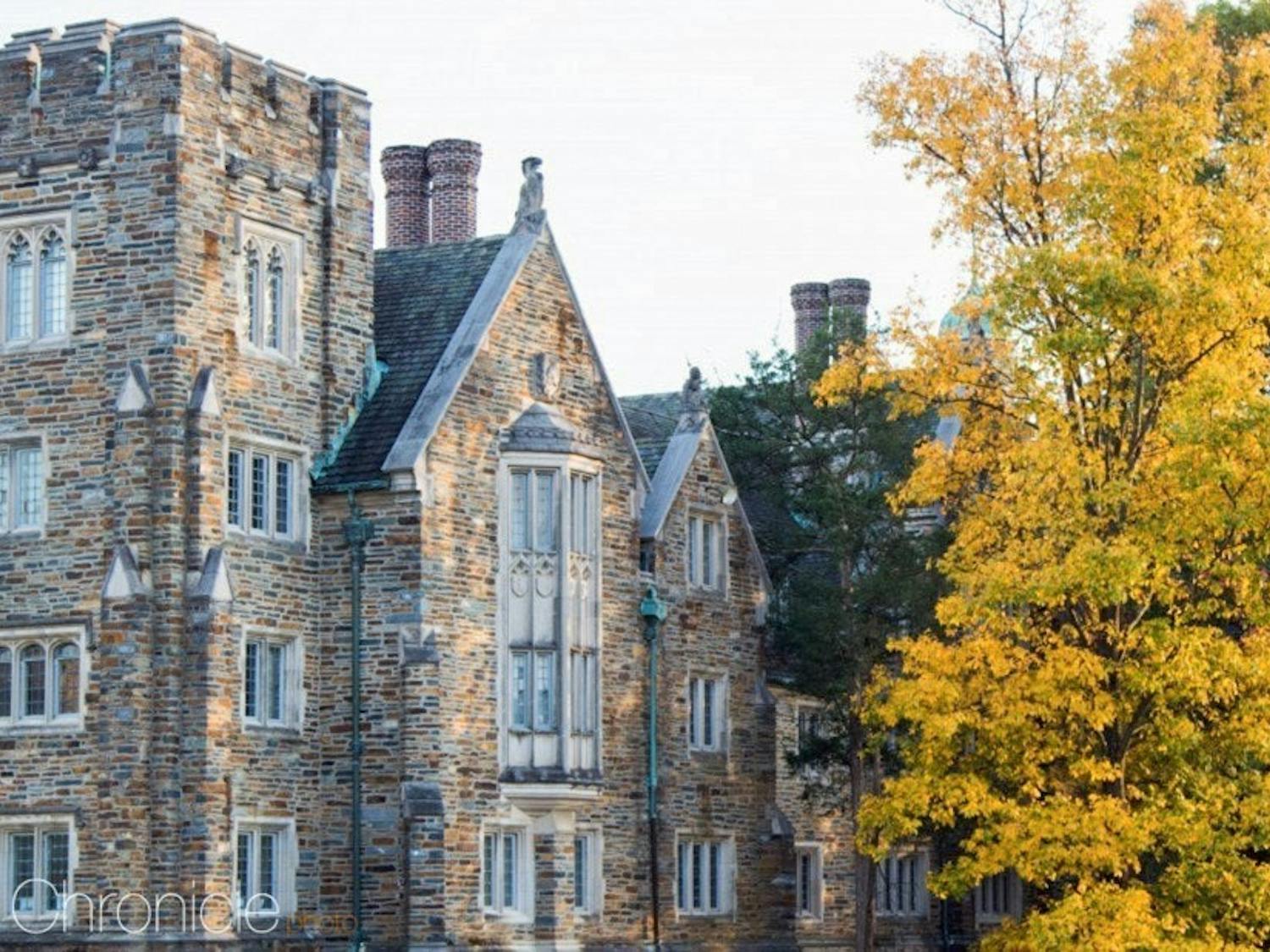Stephanie Lipscomb was 20 years old when she was diagnosed with Stage IV glioblastoma—a tumor in her brain the size of a tennis ball.
The nursing student thought that she had months to live.
She entered a clinical trial at Duke in 2012 that provided a seemingly miraculous recovery. Nearly five years later, she remains cancer-free.
Lipscomb’s story was covered extensively in a recent 60 Minutes special on breakthrough cancer research at Duke. The research that led to her treatment, however, has been decades in the making.
For most cancer patients, treatment options have traditionally centered around the so-called “three pillars”—surgery, radiation therapy and chemotherapy—explained Smita Nair, an associate professor of surgery and pathology and the leader of Duke’s Tumor Microenvironment/Immunotherapy Focus Group.
In the past several years, however, researchers at Duke and across the globe have made significant advances in re-purposing the body’s natural immune defenses, using these modifications to directly attack cancer.
This approach, called immunotherapy, has been decades in the making, Nair said, noting that countless setbacks have preceded major breakthroughs in the field.
In one well-publicized example, scientists at Duke’s Preston Robert Tisch Brain Tumor Center engineered a modified version of the poliovirus that could be used to treat brain tumors in some patients who had exhausted all other options. The poliovirus was developed and refined through decades of work by Dr. Matthias Gromeier, a professor of neurosurgery, explained Dr. Peter Fecci, the leader of Duke’s Brain Tumor Immunotherapy Program.
Fecci added that the design of the modified poliovirus lets it latch on to tumors, where it then attracts the body’s immune cells to target the virus and attack the tumors at the same time.
In 2012, Duke began its first clinical trial for the treatment, enrolling 65 patients with glioblastoma, a notoriously aggressive brain tumor. Twenty percent of the patients survived for more than three years, compared to the historical four percent survival rate. In May, the poliovirus therapy was awarded “breakthrough” status by the Food and Drug Administration, and the Brain Tumor Center’s findings were showcased shortly thereafter in a 60 Minutes special.
“In the aftermath of the special, the phone was off the hook here with people wanting access to trials, even people with tumors that none of these trials were even appropriate for,” Fecci said. “We can’t treat everyone unfortunately, but we would love to have every patient come to Duke.”
Humble beginnings
Duke’s success was not the first major breakthrough in immunotherapy, however, with many tracing its clinical roots to researcher James Allison and his development of a class of drugs called checkpoint inhibitors. By blocking checkpoints which normally act as “brakes” to keep immune cells from attacking cancer, these drugs can actually activate the immune response.
Allison developed the first checkpoint inhibitor, called ipilimumab, which was approved by the FDA in 2011 for treating aggressive melanoma.
Ipilimumab’s groundbreaking success marked the beginning of an explosion in immunotherapy treatments, bringing more funding and public attention to the field.
But for researchers in the fields of immunology and cancer biology, immunotherapy can be traced back much further in time.
“Research and the basic [science] is always critical,” said Luis Ariel Sanchez-Perez, an assistant professor of neurosurgery and researcher in the Brain Tumor Immunotherapy Program. “Immunotherapy was in that area since the 60s and 70s when knowledge was being acquired and we were trying to understand it all. Close to 2000 and 2010, people felt that there was a good background and implementation of it, and it became much more trustworthy because we thought we knew what we were doing.”
Although the checkpoint inhibitors and poliovirus therapy have made the biggest splash in the headlines so far, investigators at Duke and elsewhere have developed other approaches—including dendritic cell vaccines and CAR T-Cell therapies.
Sanchez-Perez added that as a whole, recent clinical advances have been highly encouraging to both scientists and physicians and have also emphasized the need for more basic research.
For the general public, however, the importance of such research may not be as obvious.
“The basic knowledge—it’s not that it has taken less of a priority, but it keeps revolving in the background,” Sanchez-Perez said. “But in the clinic, what is taking everything by storm are these things, the CAR–Ts and the checkpoint inhibitors. It’s just what you see on the front page, that’s what draws more attention because of the efficacy that it is having.”
A beacon of hope for patients
Fecci said that Duke’s success with the polio virus was also built on decades of research, beginning in the 1960s with Darnell Bigner, the director of Duke’s Brain Tumor Center.
Bigner’s foundational work with glioblastomas has propelled the Brain Tumor Center into the international spotlight, Fecci and Nair noted, drawing the attention of both potential patients and faculty.
“I feel that the way an institution becomes great is by promoting good science, and maintaining that productivity,” Nair said. “It has brought people to us to do research which brings [funding] money.”
Fecci explained that the Brain Tumor Center is renowned for featuring a vast selection of treatment options, developed both by Duke faculty as well as pharmaceutical companies. Duke also surpasses its peers in the number of immunotherapies and other experimental chemotherapies offered for brain tumors, he added.
“That is what sets us head and shoulders above many other places—availability of a large number of those therapies to patients,” Fecci said.
Fecci added that the Brain Tumor Center has also remained selective in the types of clinical trials it accepts for study, given its goal of providing “the best therapies” instead of the most therapies.
“There’s pressure to have these types of trials available to everybody, but you can’t fall victim to that pressure and just have therapies available without knowing that they’re going to do some good,” he said.
Looking at national trends, Nair noted she felt that many factors have contributed to Duke’s reputation today in the immunotherapy field.
Duke’s strongest asset is its broad patient population, she said, which has swelled due to the University’s position as one of the few major research hospitals in the Southeast. As a result, many pharmaceutical companies will actively seek out clinical trial partnerships at Duke, eager to cater to the patients who request such options.
“If experimental clinical trials at Duke lead to benefits [longer life] in patients, that automatically brings in philanthropy dollars,” Nair said. “My understanding is that philanthropy dollars drive [just as much] research as funding. Patient benefit drives philanthropy dollars, which promotes continuation of good science and becomes newsworthy.”
Although the Brain Tumor Center has built a stable global reputation, Nair did note that she feels Duke is now competing with more institutions for funding and faculty in the field.
As immunotherapy has become more recognized in the fight against cancer, other groups across the country are building their own programs, many of which carry significant financial backing, she explained.
Nair compared growing a research institution to managing a football team, where those with the most resources often end up with the biggest academic stars. In Duke’s case, Nair and Sanchez-Perez noted that several of their strongest former faculty members might have left for greener pastures.
Despite setbacks, Sanchez-Perez said the University is working toward developing the immunotherapy program and making it one of the key features of cancer research and treatment at Duke.
Where immunotherapy is going
Duke’s recent immunotherapy successes have also captured the attention of federal officials, some of whom are strong advocates for cancer research.
In February, Vice President Joe Biden visited Duke to promote the Cancer Moonshot, an initiative aimed at consolidating federal efforts with those of researchers and clinicians, with the objective of expanding access to new treatments and potentially working toward a cure.
Immunotherapy has also gathered interest from several well-funded private groups, many of which have made contributions to the field. Some initiatives, however, have concerned Fecci because of their well-intentioned but poorly executed ideas.
“Everyone and their grandmother is going to try and come out with some trial... and get patients through their door,” Fecci said. “A lot of those trials are constructed illogically or even potentially immorally, and it’s going to become more important now to actually discern whether somebody has a good study open.”
When the poliovirus trial was awarded breakthrough status by the FDA in May, Bigner emphasized that although this designation could expedite the development of this treatment, it did not mean the poliovirus would be necessarily be approved by the FDA.
Sanchez-Perez noted that full approving of certain immunotherapies can sometimes be a 20-year process and that the breakthrough status might cut this down to 10 or 15 years for the poliovirus therapy.
Even with this status, approving the poliovirus treatment for public use would be no trivial matter, and for good reason, Nair explained.
“It is in the interest of the scientists and the Duke doctors to be as careful as possible,” she said. “So not only is the FDA process strict, these [researchers] are very slow and steady. The last thing we will do is rush through anything. If something fails, that’s a nightmare scenario that no one wants to see, and it could fail if you don’t think it through properly.”
Critics of the announcement quickly claimed that awarding Duke for its success with glioblastoma was premature and circumvented the rigorous approval process already in place.
In Nair and Sanchez-Perez’s opinion, however, the trial’s breakthrough status reflects how the patients in these trials are all out of options, with the poliovirus offering them their last chance at life.
“When people talk about the poliovirus and the breakthrough, they need to understand there’s a context there,” Sanchez-Perez explained. “[The trials are] in patients with recurrent glioblastoma, in which the survival time is six months. They have failed everything.”
However, even with these advances, the poliovirus treatment is not a panacea for treating all brain tumors, and oncologists will likely never completely abandon their traditional approaches for new immunotherapies, Fecci noted.
“It’s not going to be the smoking gun. It’s going to need to be used in conjunction with other therapies,” he explained.
Duke’s cancer goals
As Duke draws more funding for clinical trials and basic immunology research, Nair, Sanchez-Perez and other members of the Tumor Microenvironment/Immunotherapy Focus Group hope to broaden the University’s collaborative spirit from within instead of beyond, forging relationships across departments including statistics and surgery.
Because Duke does not have a formal immunotherapy department, Nair said investigators in different departments might not have the chance to meet potential collaborators.
“Sometimes you forget that you have those people in your own backyard as well,” she said. “In your own institution, people get lost a little bit and don’t see who is doing [immunotherapy] here and who is doing it there.”
Nair said she hopes to build her Focus group as a kind of representative body, where experts from each of Duke’s health divisions come to meetings and later share those discussions with their colleagues.
In the long run, Nair, Sanchez-Perez and Fecci agreed that Duke will need to make continued investments to truly secure its role in the future of immunotherapy.
“I call it homegrown science,” Nair explained. “If there’s homegrown science of value, we need to find a way to help the Duke scientist move to [the first phase of] clinical trials.”
Fecci added that as immunotherapy gains momentum, Duke should also focus on streamlining its broader research goals to “make the quality of our research increase, and make the quality of our trials increase.”
Duke is also in a prime position to expand research and clinical trials in rarer diseases, such as pediatric cancers or testicular cancer, Nair said.
Equally important would be a greater emphasis on the healthcare policy behind immunotherapy, Nair said, adding that some immunotherapy options can cost patients hundreds of thousands of dollars per year.
Because most immunotherapies are only available as clinical trials, costs are typically absorbed by their pharmaceutical developers, she explained. As more immunotherapies start hitting the market, however, how patients will afford them is less clear.
“Ultimately, it is patient care, and to some extent that’s a conversation we should have more with the [clinicians],” Nair said. “Who is looking at the healthcare aspect of this?”




